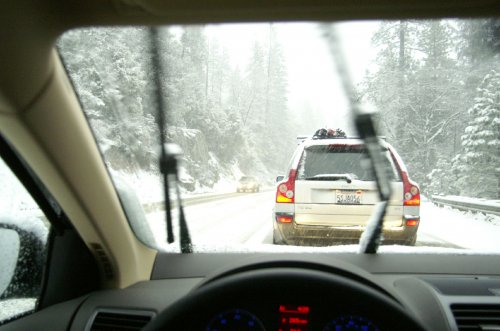|
I came of age in
Montana. Since I was a
kid, I have seen it snow every month of the year, except July.
And it has snowed in July in some places in Montana, I hear.
Driving in snow, ice, and slush indeed presents its
challenges, especially when trying to stop safely.
I recall my
older brother driving my classmate and me home from school one nasty
winter day. He stopped
on the icy road to drop off my friend.
Smash! In an
instant, we all experienced Newton’s first law of motion:
Every
object moves in a straight line unless acted upon by an outside
force. The
car behind us moved in straight line all right as it slid into our
back bumper, breaking both of its front headlights.
When I turned
fifteen, I took driver’s education.
Our teacher impressed on us tactics for driving during winter
conditions. Slamming on
the brakes would most likely precipitate skidding, which was not a
good thing. Pumping the
brakes was our best ally to literally get a better grip on the road.
It wasn’t until I entered college that I fully understood
the physics behind this winter driving wisdom.
Our freshman
college course concentrated on the laws of motion.
The most prevalent natural force in the universe is gravity.
Another pervasive macroscopic force is friction.
And there are different kinds of friction – static and
kinetic.
One of our
“real fun” physics labs was to measure coefficients of friction
(commonly denoted as µ) for µ (static) and µ (kinetic).
Our lab instructor directed us to put metal bricks on ramps.
These bricks were tethered to a line stretched over a pulley
and attached to counter weights, which would tend to pull the brick
up the ramp. Then we
would pile on counter weights to observe the balance of forces
acting on the brick: The force of gravity on the brick and friction was equal
and opposite to the force of counter weights.
(Check
out, if you wish, the following applet for a demo:
http://lectureonline.cl.msu.edu/~mmp/kap4/cd095a.htm)
We needed to
note the counter weight (force) on the brick the moment it started
sliding up the ramp. This
measurement allowed us to calculate the “static” coefficient of
friction, µ (static). It
got even trickier when the brick started moving.
We had to adjust the counter weights and ensure the brick was
moving at a constant velocity. The
new value of the counter weights allowed us to calculate the
“kinetic” coefficient of friction, µ (kinetic).
The point of the
lab was to show that the “static” and the “kinetic”
coefficients of friction for the same materials were different.
Indeed, the static value was greater than the kinetic.
Hence, we usually had to nudge the brick to get it moving to
overcome static friction.
What does
this have to do with winter driving?
Everything.
If the driver
slams on the brakes and the tires lock, the immobile tires are
sliding on the surface beneath it.
Hence the friction is “kinetic” since the two surfaces
are moving relative to each other.
If the driver pumps the brakes to keep the tires rolling, the
point of contact of the tires to the surface is at rest relative to
one another. Therefore,
the friction is “static.”
Here are some
measured values for the coefficients of static and kinetic friction
of tires on different surfaces (courtesy of http://ffden-2.phys.uaf.edu/211_fall2002.web.dir/Ben_Townsend/StaticandKineticFriction.htm):
Surfaces
µ (static)
µ (kinetic)
Tire on
concrete
1.00
0.80
Tire on wet road
0.60
0.40
Tire on snow
0.30
0.20
The table above
shows that rolling tires, gripping the road with static friction,
have greater friction than locked tires, sliding on the road with
kinetic friction, whether the surfaces are dry, slushy, or snowy.
Therefore, rolling tires have the best chance of stopping the
vehicle safely. In fact,
many cars today have computerized anti-lock braking systems (ABS),
which will sense the rotation of the tires and prevent the wheels
from locking while braking.
Coefficients of
friction may not be the most exciting topic, but their application
is very practical. As
for my driver’s education teacher, his advice was backed by the
sound physics - literally where the rubber meets the road.
So pump those
brakes (or get a smart car to do it for you) and be safe!
|


